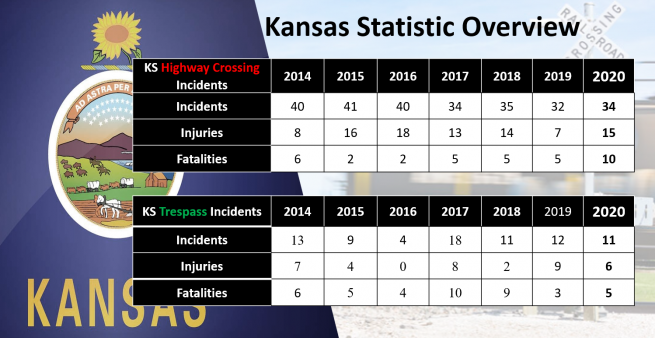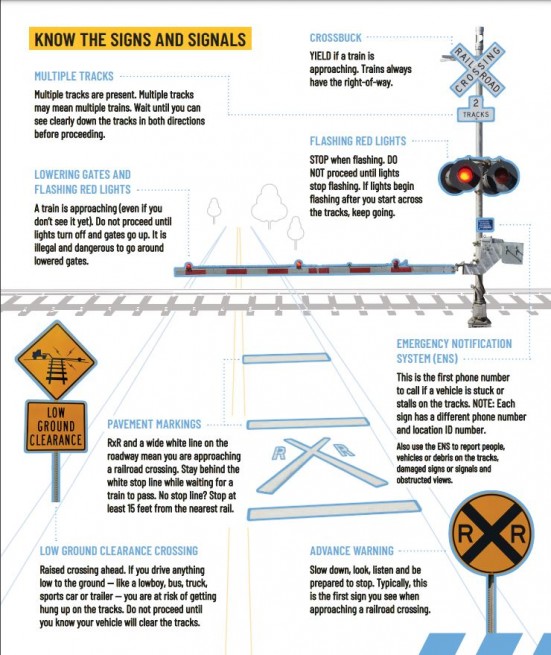Kansas Operation Lifesaver
About KS OL

In America, a person or vehicle is hit by a train roughly every three hours, and that's a reality we are committed to change.
Kansas Operation Lifesaver is a non-profit public safety education and awareness organization dedicated to reducing collisions, fatalities and injuries at highway-rail crossings and trespassing on or near railroad tracks. Injuries and fatalities that occur at highway-rail crossings or on railroad property are a real, but often preventable. We are committed to providing the educational resources and necessary solutions to help resolve this problem.
Our Mission
Operation Lifesaver is a nonprofit rail safety education and public awareness organization dedicated to saving lives.
KS OL Events

RSVP For KS OL 50th Anniversary Celebration
Sunday, September 8th 2:00 - 6:00 pm
Great Plains Transportation Museum
700 E Douglas, Wichita, KS 67202
Upcoming Events
August 8, 1:00 - 3:00: KS OL Board & Committee Meeting,
Topeka & Shawnee County Public Library, Hughes Room, 205 1515 SW 10th Ave, Topeka, KS 66604
Quarterly News Letters
Current Issue
See below for more issues

2023
- Fourth Quarter Sunflower Signal
- Third Quarter Sunflower Signal
- Second Quarter Sunflower Signal
- First Quarter Sunflower Signal
2022:
- Fourth Quarter Sunflower Signal
- Third Quarter Sunflower Signal
- Second Quarter Sunflower Signal
- First Quarter Sunflower Signal
2021:
- Fourth Quarter Sunflower Signal
- Third Quarter Sunflower Signal
- Second Quarter Sunflower Signal
- First Quarter Sunflower Signal
2020:
- Fourth Quarter Sunflower Signal
- Third Quarter Sunflower Signal
- Second Quarter Sunflower Signal
- First Quarter Sunflower Signal
2019:
KS OL Statistics

In the last ten years Kansas has seen 495 incidents, resulting in 195 injuries, and 109 deaths. Even as numbers decrease, Kansas consistently has 3-4 people involved in incidents each month. That is almost once a week!

Some National stats that may surprise you:
Every three hours someone in the United States is hit by a train.
- 95% of these incidents could have been prevented if drivers followed traffic laws.
- 85% of all motor vehicle/train collisions occur because the vehicle did not stop at a crossing.
- 90% of crossing incidents are men ages 25-55.
Every 5 days a child is killed in a train collision in the United States.
- Teens ages 15-19 are four times more likely to be involved in an incident.
- Boys are three times more likely than girls to be involved in an incident.
- 71% of parents are not concerned about their child potentially being hit by a train.
Become a Volunteer

We are always looking for high-energy volunteers to help us spread our important message. Our volunteers are everywhere—schools, training programs, law enforcement events and safety fairs—with the common purpose of keeping our citizens safe. You can begin the process today by clicking here.
Why Volunteer
You can help make your community safer by becoming an Operation Lifesaver Authorized Volunteer (OLAV). Each year, Operation Lifesaver's trained Volunteers conduct free programs on rail safety education for audiences in large and small communities across the United States. Why not join them?
Steps to becoming an Operation Lifesaver Authorized Volunteer (OLAV)
- Prospective Volunteers fill out and submit the online OLAV application, which is then reviewed by their Operation Lifesaver State Coordinator. Applicants will receive an email telling them how to go to the next step in the process, the online classroom training.
- Next, applicants complete the online classroom, “The AVE” (Authorized Volunteer e-Learning), which is available 24/7, whenever it fits YOUR schedule. You can save your progress in the online training module, and are encouraged to complete it over more than one session.
- After completing the AVE online classroom, your state coordinator will contact you to schedule the next step to complete the OLAV process.
- Authorized volunteers will report their safety activities via Operation Lifesaver’s online reporting database, so they can easily keep track of their presentations, training and special events.
- With the new OLAV program, OL volunteers will have more options to choose from for interacting with an audience.
- Volunteers must fully understand and agree to abide by all OLI general policies and procedures as stated in the volunteer application.
Driver Information


When locomotive engineers see a vehicle or person on the tracks in the path of their train, they can only sound the warning horn and apply the emergency brakes.
A train in emergency braking will stop, but not in time to avoid this collision. The average freight train takes over a mile to stop in emergency braking.
Look in both directions and listen for trains
when signs indicate you're approaching a rail crossing. Keep in mind that In rural areas, not all crossbucks have flashing lights and gates that come down. Cross only when it's safe to do so.
Never stop on railroad tracks.
Remember that a train cannot stop quickly or swerve out of the way. If you're stopped on the tracks, you risk injury or death.
Watch for vehicles that must stop before they cross train tracks.
These vehicles include buses, school buses, and trucks transporting hazardous loads.
Remember that flashing red traffic signal lights mean STOP!
Stop at least 20 feet, but no more than 50 feet, from the nearest track.
Never go around lowering gates or around lowered gates.
Flashing red warning lights indicate you must stop and wait. Don't proceed over the railroad tracks until the red lights stop flashing, even if the gate rises.
If the gates are lowered and you don't see a train approaching, call the posted railroad emergency toll-free number or 9-1-1. Be ready to give a detailed description of your location.
Always expect a train. Trains don’t run on set schedules. They can be on any track, at any time, going in either direction.
Always yield the right of way to the train. The train cannot yield to you.
More than half of all motor vehicle-train collisions occur at crossings equipped with automatic signals. It’s because some drivers choose to drive around the gates or through flashing red lights because they think they can beat the train or they assume either a stopped train has activated the signals or the signals are malfunctioning.
Never ignore active warnings at crossings because of what you think you see.
Locomotives are huge — 17 feet high and 10 feet wide. As a result, they appear to be traveling much slower than you think when viewed from a slight angle at the crossing. The combination of the size and angle creates this illusion. The parallel lines of the rails converging toward the horizon contribute to the illusion and fool your mind into thinking the train is farther away than it actually is.
Keep in mind that trains will arrive at a crossing faster than you anticipate.
One in four crashes occurring at highway-rail crossings takes place when drivers run into the side of the train. Often, it’s because the driver is traveling too fast for conditions, such as darkness, rainy weather, or fog. Also, many drivers “overdrive their headlights” — drive too fast to be able to stop in the distance illuminated.
Don't try to pass another vehicle when you see advance-warning signs indicating a rail-highway crossing ahead.
The vehicle being passed may obstruct a clear view of the tracks, or vehicle speed while passing may be too great to stop in time.
Before starting across the tracks, be sure there's room to get completely across.
Many crossings are on a surface higher than the roadway. Shifting gears with a manual transmission while going across this raised surface may cause the vehicle to stall on the tracks. If your vehicle is ever stalled or trapped on the tracks and a train is approaching, quickly get yourself and all other passengers out! Don’t try to take any other items with you.
When running away from a vehicle stuck on tracks, run away from the tracks at an angle in the direction of the approaching train.
When the train strikes the vehicle, it will send flying metal and glass ahead of and outward from the locomotive. If a train is not approaching when a vehicle is stuck on the tracks, you still need to get yourself and all other passengers out of the vehicle and to a safe location. At crossings there are signs with a toll-free number to call the railroad directly and warn employees of stalled vehicles or other problems at the crossing.
When a crossing has more than one track, don’t try to cross immediately after the end of the train passes — there may be another train approaching on the second track.
Many crossing crashes have resulted because of impatience or inattentiveness at multiple-track crossings. You’ll always know how many tracks are at the crossing by observing a sign posted under the crossbuck.

OLAV Resources

Here you will find forms and other helpful information for OLAVs
Graphics & Media:
Graphics Link
Radio PSAs: Denny Matthews; spot 1, spot 2, spot 3
Radio PSAs: General Announcer; spot 1, spot 2, spot 3
Radio PSA: Dave Lewis; Farm Equipment at Crossings
Events & Sunflower Signal
Helpful Sites
FRA Highway-Rail Grade Crossing Safety & Trespass Prevention
FRA Trespass Incident Workbook
FRA Rail Crossing Incident Workbook 2011-2020
FRA Highway/Rail Grade Crossing Dashboard
FRA Query by Crossing
FRA Trespassers Map
Safe Kids; Railroads an Often-Overlooked Danger to Children


